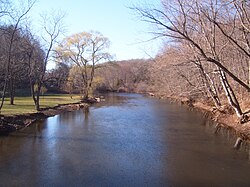 The Quinnipiac River looking west into the Quinnipiac River Gorge | |
| Total population | |
|---|---|
| extinct as a tribe; merged into the Stockbridge Munsee Community and Brotherton Indian Community, now in Wisconsin [1] | |
| Regions with significant populations | |
| United States (Connecticut) | |
| Languages | |
| Quiripi language | |
| Religion | |
| Indigenous religion | |
| Related ethnic groups | |
| other Wappinger peoples |
The Quinnipiac were a historical Indigenous people of the Northeastern Woodlands. They lived in present-day New Haven County, Connecticut, along the Quinnipiac River. [2] Their primary village, also called Quinnipiac, was where New Haven, Connecticut is today. [3]
